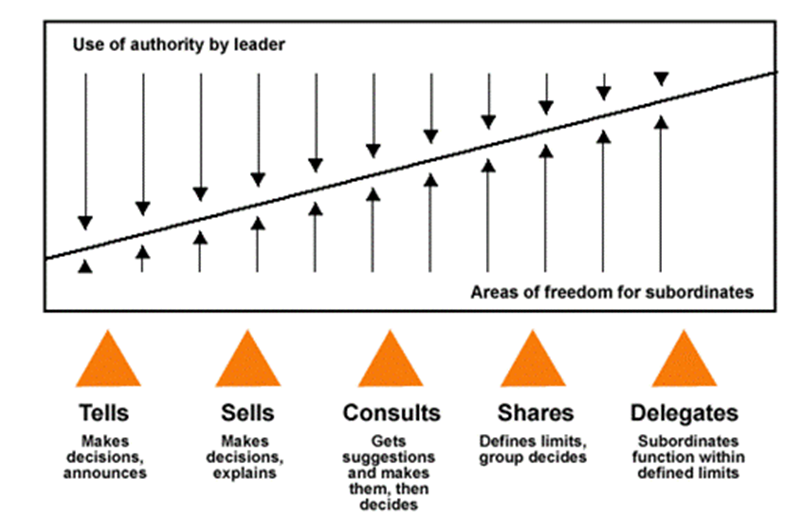Leadership

The majority of authors do acknowledge that “there are almost as many different definitions of leadership as there are people who have tried to define it” (Northouse, 2010, p.2). Nevertheless, one of the most popular definitions of leadership has been proposed as “the influencing process of leaders and followers to achieve organisational objectives through change” (Lussier and Achua, 2010, p.6). More straightforward definition of leadership can be worded as “the ability to guide others, whether they are colleagues, peers, clients, or patients, toward desired outcomes” (Marshall, 2011, p.2). Leaders have been explained as “people who have a clear idea of what they want to achieve and why” (Doyle and Smith, 2009, p.1). The term of leadership can also be defined as an activity or the ability of leading people towards the achievement of a common goal (Gold et al., 2010). Leadership definitions are divided by Northouse (2010) into two categories: trait and process. The following figure illustrates the nature of the impact of leaders on followers according these two alternative categories of definitions: Trait and Process definitions of leadership Source: Northouse (2010) The definition of strategic leadership read as “behaviour that depends on combining perceptions of threats opportunities, cognitions, analyses, and risk preferences” (Bass and Bass, 2008, p.43). A related term, ‘charisma’ has been defined by The Free Dictionary (2012) as a rare personal quality attributed to leaders who arose fervent popular devotion and enthusiasm. Additional alternatives of leadership definition “the ability to inspire confidence in and support among the people who are needed to achieve organisational goals” (DuBrin, 2012, p.28). “the discipline of deliberately exerting special influence within a group to move it toward goals of beneficial permanence that fulfil the group’s real needs” (Haggai, 2009, p.20) “an influence relationship among leaders and followers who intend real changes…

Widely considered as a controversial genius and a charismatic leader, Steve Jobs has served as chairman and CEO of Apple for 14 years and he is credited for the global success of the company. The decease of Steve Jobs on October 5, 2011 because of cancer implications resulted in grievances for millions of people around the globe, at the same time casting concerns for the future of Apple Inc. Although, a long-term Apple executive with impressive track record – Tim Cook has been named apple CEO several months before the decease of Steve Jobs, nevertheless, there are concerns about the sustainability of Apple’s innovative corporate culture, as this culture had been closely associated with the former CEO. Apple Organisational Culture on Steve Jobs Era Late Apple chairman and CEO, Steve Jobs is widely perceived as unconventional leader who was able to rally various stakeholders of the company for his vision and at the same time “demanded excellence from his staff and was known for his blunt delivery of criticism” (McInerney, 2011). According to Harrison’s Model of Culture (1972) Apple organisational culture when Steve Jobs was in charge can be classified as a power culture. Accordingly, Steve Jobs had concentrated most of the decision making powers at his hands, constantly challenging subordinates for better performance, and criticising employees blatantly and undiplomatically if their performances did not meet his expectations (Arneson, 2011). Moreover, described as “antithesis of servant leadership model” (Katzenbach, 2012), Steve Jobs was famous for pressurising teams and individuals to better performance and creating a corporate culture of high level of performance where A list employees would thrive, however B list employees, comprising the majority of workforce, would be subjected to unnecessary level of stress. According to Harrison’s Model of Culture (1972) the power culture has both advantages, as well…

Transactional leadership style has been explained by Krogh et al (2011) as a type of transaction between employees and management where the total obedience of employees is exchanged for the pay they receives for their work. According to Fitzsimons (2011) reward and punishment are the main tools that are used in transactional leadership in an intensive manner. Specifically, transactional leaders tend to punish low performance with specific measures, whereas exceptional performance usually gets rewarded. Transactional leaders usually perceive their main role to consist of clarifying role and task requirements for employees and demanding results regardless of the quality of resources provided to them. Moreover, there are set of other serious shortcomings that are associated with transactional leadership style. First of all, according to transactional leadership theory employees need to be closely monitored in order to perform their job responsibilities in a desired level. Lindebaum and Cartwright (2010) argue that close monitoring of employees may negatively affect the level of their motivation in certain job positions that require creativeness and ‘thinking outside of box’. Besides, Pieterse et al (2010) convincingly argue that transactional leadership limits the level of employee innovative behaviour due to its increased focus on in-role performance, rather than the motivation of the workforce. Furthermore, according to the transactional leadership theory obeying the instructions and commands of people in leadership positions is perceived to be the primary task of employees. While such a principle might be highly effective for certain types of organisations such as military where the orders of leadership cannot be questioned; for business entities the adoption of transactional leadership style might compromise the level of competitiveness of the organisation, because the potential of employees of contributing to the level of competitive edge through the expression of personal initiatives would be suppressed. It has been stated that…

In its essence, path-goal theory represents a framework for analysing the manner in which leaders motivate employees to achieve organisational objectives. Specifically, “the path-goal leadership model is used to select the leadership style (directive, supportive, participative, or achievement oriented) appropriate to the situation (subordinate and environment) to maximise both, performance and job satisfaction” (Lussier and Achua, 2010, p.161) Path-goal model perceives the main purpose of leadership in increasing the level of employee performance thorough increasing the level of their motivation. Under the path-goal model leadership behaviours are divided into the following four categories: a) Directive leadership – leader is mainly engaged in clarifying expectations, deadlines and outcome standards. Leaders give guidance and directions to subordinates for performance b) Supportive leadership – being friendly and approachable, supportive leaders treat each member of the workforce as equal, and care about their well-being to a great extent. Leader shows concern and cares about subordinates c) Participative leadership – employee input is integrated in decision making process by the leader through initiating discussions and encouraging employees to share their opinions regarding various organisational processes. Leader listens to subordinates and considers their suggestions. d) Achievement-Oriented leadership – increased level of performance is achieved by leaders from subordinates through assigning challenging tasks and setting high performance standards. Leader’s goals are high and expectations for subordinate’s performances are also high. It is important to note that path-goal leadership model attracts a set of criticism that includes incorporating many aspects of leadership within a single model and a failure to represent the nature of relationship between leadership practice and employee motivation in a detailed manner. References Lussier, R.N. & Achua, C.F. (2010) “Leadership: Theory, Application, & Skill Development” 4th edition, Cengage Learning

Leadership Continuum Theory is a contingency leadership theory developed by Tannenbaum and Schmidt (1958). This theory is based on the idea that many classifications of leadership such as autocratic or democratic are extremes and leadership practices in real life situations lye somewhere between the two extremes. In other words, the main rationale behind the introduction of the model is that current classifications of leadership styles are too general, in black and white terms, and in reality leadership practices exercised by the majority of organisational managers lies somewhere in the middle. Tannerbaum and Schmidt’s Leadership Continuum Theory effectively addresses the criticism that leadership styles cannot be described in highly general ‘authoritarian’ or ‘democratic’ manners, and the actual leadership styles practiced in the majority of organisations lie somewhere between the two (Gosling et al, 2003) Accordingly, Tannenbaum and Schmidt (1958) propose the idea of leadership continuum and place different variations of leadership practices along the continuum that move from autocratic leadership style towards democratic. Specific leadership styles specified within the continuum include telling, selling, consulting, and joining leadership styles. The Leadership Continuum Theory represents a just and valuable framework for analysing leadership style. This is because the theory provides wider options for the classification of leadership style, and thus has a high level of applicability in the real life business management. However, according to the criticism of Leadership Continuum Model “three factors to consider when selecting a leadership style are very subjective. In other words, determining which style to use, and when, is not clear in the model” (Lussier and Achua, 2010, p.161). References Gosling, B.R., Marturano, J. & Dennison, P. (2003) “A Review of Leadership Theory and Competency Frameworks” University of Exeter Lussier, R.N. & Achua, C.F. (2010) “Leadership: Theory, Application, & Skill Development” 4th edition, Cengage Learning Tannenbaum, R.…

The earliest contingency theory is Fiedler’s theory. According to Fiedler & Garcia (1987, p.54) situations will create different leadership styles which are required for managing contingent on a set of factors effecting the situation. Contingency theories perceive leadership styles to be either task motivated or relationship motivated. “Fiedler’s leadership contingency argues that team effectiveness depends on an appropriate match between a leader’s style, especially a trait measure, and the demands of the situation” (Schermerhorn et al., 2011, p.297). According to this theory the group performance depends on leadership style and situational favourableness, and three aspects to focus on are: A) Relationship between leaders and the followers B) Structure of the task C) Position power of leader In accordance to the contingency theory Fiedler (1996) specifies three important situational dimensions that influence the level of effectiveness of the leader: leader-member relations, task structure, and position power. Leader-member relations relate to the degree of confidence that subordinates have in leader, as well as, the extent of their loyalty. Accordingly, in situations where a leader is accepted by the members of the group, the leader would be in a more favourable situation to lead the group. In contrary, in situations where the level of loyalty to the leader is low effective leadership would prove to be a highly challenging task to accomplish. The task structure situational dimension, on the other hand, relates to the level to which the jobs of followers are routine as opposed to non-routine. Factors determining the nature of the task structure include the level of understanding of the task by relevant parties, the ways of accomplishing the task, and the numbers of correct solutions to the problem (Gold et al., 2010). Position power is the power that is innate in the leadership position. The extent of position…

A comprehensive project on leadership has been conducted by Alimo-Metcalfe and John-Metcalfe (2000) with the participation of more than 3,500 managers and professionals along different levels of management employed within UK National Health Service and local government that were selected on the basis of gender-inclusive and black and minority ethnic-inclusive sample. The findings of this specific project have enabled the development of 360-degree feedback tool, also known as Transformational Leadership Questionnaire. The most notable distinctive point associated with this project compared to others relates to the fact that Alimo-Metcalfe and John-Metcalfe (2005) this model adopts ‘nearby’, instead of ‘distant’ or ‘heroic’ approaches on leadership. The Transformational Leadership Questionnaire is based on the following scales: Scale 1 Genuine concern for others’ well-being and development Scale 2 Political/stakeholder sensitivity and skills Scale 3 Inspirational networker and visionary promoter Scale 4 Empowers, delegates, develops leadership potential Scale 5 Integrity, consistency, honesty, and openness Scale 6 Accessibility, approachability, sensitivity Scale 7 Decisive, determined, self-confident, resilient Scale 8 Clarifies boundaries, involves others in decision making Scale 9 Encourages critical and strategic thinking The Transformational Leadership Questionnaire scales Scale Source: Alimo-Metcalfe & Alban-Metcalfe (2000) Practical implications of the work of Alimo-Metcalfe and John-Metcalfe (2000) can be interpreted in a way that the concept of transformational leadership “far from being a key to a learning organisation, may itself be in considerable need of rethinking and revision” (Doyle, 2003, p.215). References Alimo-Metcalfe, B. & Alban-Metcalfe, J. (2000) “A New Approach to Assessing Transformational Leadership” Section and Development Review, 16(5), pp. 15-17 Doyle, C. (2003) “Work and Organisational Psychology: An Introduction with Attitude” Psychology Press

According to the Great Man theory leaders are born with a set of specific skills and traits that makes an individual destined for a leadership position. Also known as a trait perspective to leadership it suggests that “certain individuals have special innate or inborn characteristics or qualities that differentiates them from non-leaders” (Northouse, 2010, p.4). Specifically, these characteristics were believed to include height, weight, appearance, intelligence, disposition and others. Furthermore, “charismatic and inspirational leaders instil faith in a better future for the followers in terms of their self-expression, self-evaluation, and self-consistency” (Bass and Riggio, 2006, p. 39). Analysis of the ‘Great Man’ theory has a direct relevance to this study. It has been noted that “through most of the imperial period, literate Chinese had a Great Man theory of how their civilisation developed” (Ebrey, 2010, p.10), and thus, the theory might have impacted upon the current pattern of Chinese-style leadership. Therefore, specifications, major viewpoints, and main criticisms associated with the Great Man theory need to be analysed in a great detail within the scope of the literature review. Critics of the Great Man theory note that “leadership is an identifiable set of skills and practices that are available to all of us, not just a few charismatic men and women. The “great person” – woman or man – theory of leadership is just plain wrong” (Kouzes and Posner, 2008, p.32). Moreover, it has been argued that “leadership skills and savvy mature over time and under appropriate conditions” (Gallos, 2008, p.61), so any individual can increase the level of own leadership qualities if the individual is faced with relevant situations under appropriate circumstances. References Bass, B.M. & Riggio, R.E. (2006) “Transformational Leadership” 2nd edition Gallos, J.V. (2008) “Business Leadership: A Jossey-Bass Reader” 2nd edition, John Wiley & Sons Northouse, P.G.…

Thomas (2009) offers a comprehensive analysis of issues associated with intrinsic motivation at work. The author argues that “intrinsic rewards come to workers directly from the work they do – satisfactions like pride of workmanship or the sense that they are really helping customers” (Thomas, 2009, p.13). Three C’s of intrinsic motivation have been identified by Kohn (1993) as collaboration, content and choice. Specifically, according to Kohn (1993), collaboration involves creating an atmosphere where employees can cooperate with each-other as team members, whereas, content relates to understating the manner in which any specific job adds value and contributes to the achievement of organisational objectives. Choice element of intrinsic motivation, on the other hand, involves providing greater freedom and autonomy to employees in terms of dealing with their responsibilities, and increasing the level of their involvement in decision-making. It is important to note that although the theoretical framework of three C’s of intrinsic motivation has been introduced by Kohn (1993) almost two decades ago; it is still adequately relevant in modern work environment. References Kohn, A. (1993) “Punished by Rewards: The Trouble with Gold Stars, Incentive Plans, A’s, Praise, and Other Bribes” Thomas, K.T. (2009) “Intrinsic Motivation at Work: What Really Drives Employee Engagement” 2nd edition, Berrett-Koehler Store
By John Dudovskiy
Category: HRM

Described as a “complex social process, rooted in the values, skills, knowledge, and ways of thinking of both leaders and followers” (Gallos, 2008, p.1), leadership, and studies on leadership represent important points in both theoretical and practical levels. At the same time, it is important to stress that “studies of leadership differ, often greatly, in their assessment of the leader’s impact on firm performance” (Wasserman et al., 2010, p.28). Nevertheless, “leadership in management involves concern both for task performance and for people’s needs, aspirations and expectations” (Sadler, 2003, p.82) The increasing level of importance of leadership in modern organisations can be explained by referring to highly dynamic nature of the marketplace, increasing importance of employee motivation in terms of achieving organisational objectives, and constant search for additional sources of competitive advantage (Grout and Fisher, 2011) Furthermore, a direct link between the quality of organisational leadership and the level of employee motivation has established by Kellerman (2010). In a management project involving several organisations and using observation primary data collection method Kellerman (2010) has found positive correlation between the level of effectiveness of leadership practices within organisations and the level of employee motivation. According to Lepard and Foster (2003), amid the increasing importance of effective leadership within organisations the task of measuring the level of efficiency of leadership practices still remains to be complex and ambiguous. Authors further claim that “the exercise of leadership is sometimes viewed as an art that resists measurement” (Lepard and Foster, 2003, p.5). References Gallos, J.V. (2008) “Business Leadership: A Jossey-Bass Reader” 2nd edition, John Wiley & Sons Grout, J. & Fisher, L. (2011) “What You Need to Know about Leadership” John Wiley & Sons Kellerman, B. (2010) “Leadership: Essential Selections on Power, Authority, and Influence” McGraw-Hill Professional Lepard, D.H. & Foster, A.G. (2003) “Powerful…
